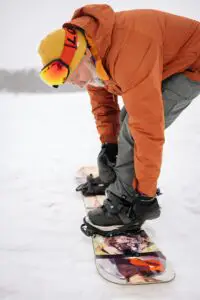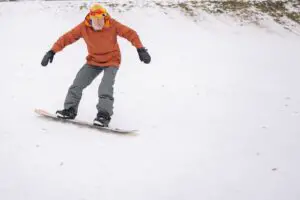Have you ever strapped on a snowboard and glided down a mountain, feeling the rush of wind against your face? Imagine that same exhilaration, but on water instead. That’s where wakeboarding comes in.
If you’re a seasoned snowboarder looking to try something new, you might be wondering: does snowboarding translate to wakeboarding? In this article, we’ll explore the similarities and differences between these two thrilling sports, uncovering tips and tricks to help you smoothly transition from the slopes to the waves.
So grab your board and let’s dive in!
Key Takeaways
- Both snowboarding and wakeboarding require shifting weight from one edge to the other while maintaining balance.
- The basic stance and body positioning are quite alike in both sports.
- Techniques used in snowboarding can translate well into wakeboarding.
- Understanding gear differences is crucial for a successful transition between the two sports.
The Similarities Between Snowboarding and Wakeboarding
Snowboarding and wakeboarding share many similarities in terms of technique and body movements. When it comes to carving turns, both sports require you to shift your weight from one edge to the other while maintaining balance.
The feeling of floating over water or snow is also similar, as you rely on the same principles of weight distribution and control. In both sports, having a strong core is crucial for stability and control, allowing you to maneuver with ease.
Additionally, the basic stance and body positioning are quite alike – knees slightly bent, hips facing forward, and arms relaxed yet ready to react.
Whether you’re shredding down snowy slopes or gliding across a glassy lake, the techniques used in snowboarding can definitely translate well into wakeboarding.
Differences in Equipment and Gear
When it comes to snowboarding and wakeboarding, the equipment variations can be quite significant. Understanding the gear differences between these two sports is essential for those looking to get involved in either or both.
From bindings and boots to boards and ropes, comparing snowboarding and wakeboarding gear will give you a deeper appreciation for the unique challenges and experiences each sport offers.
Equipment Variations Explained
To understand how equipment variations in wakeboarding differ from snowboarding, you’ll find that wakeboards are typically shorter and wider than snowboards. This difference is due to the nature of the sports.
Wakeboarding takes place on water, where stability and maneuverability are key. The shorter length allows for quicker turns and better control on the water’s surface. Additionally, the wider width provides more stability, making it easier to maintain balance while carving through wakes or performing tricks.
Snowboards, on the other hand, are longer and narrower to provide better floatation on snow and stability at high speeds.
While there are similarities between these two sports, understanding the differences in equipment is crucial for a successful transition from snowboarding to wakeboarding or vice versa.
Gear Differences Between Sports
If you’re looking to try out both sports, it’s important to understand the gear differences between wakeboarding and snowboarding. Here are three key variations that will help you navigate the world of these thrilling activities:
- Bindings: Wakeboard bindings are typically closed-toe, providing extra support and control for your feet. Snowboard bindings, on the other hand, often have an open-toe design that allows for more flexibility.
- Boards: Wakeboards are designed with a wider stance and a continuous rocker shape, allowing for better stability on water. Snowboards have a narrower stance and a camber or rocker-camber profile, optimizing performance on snow.
- Footwear: While wakeboarding requires specific bindings attached to the board, snowboarding uses boots that can be easily detached from the board when needed.
Understanding these gear differences is essential in ensuring a seamless transition between wakeboarding and snowboarding while also feeling like part of these vibrant communities. So go ahead, grab your gear and dive into the exhilarating world of board sports!
Comparing Snowboarding and Wakeboarding Gear
Understanding the gear differences between snowboarding and wakeboarding is crucial for a seamless transition between the two sports. While many of the basic principles apply to both sports, there are some key differences in the gear you’ll need.
Let’s start with the board itself. In snowboarding, you’ll typically use a longer, wider board designed for gliding over deep snow. Wakeboards, on the other hand, are shorter and narrower with bindings that allow for more maneuverability on water.
When it comes to boots, snowboard boots are insulated and designed to keep your feet warm in cold conditions, while wakeboard bindings prioritize flexibility and comfort for jumps and tricks on the water.
Lastly, don’t forget about safety equipment like helmets and life jackets – they’re essential in both sports!
Mastering Balancing and Stance
Balancing and stance are key factors in mastering snowboarding and wakeboarding. When you find your balance, it’s like unlocking a secret power that allows you to glide effortlessly across the slopes or waves.
Your stance is the foundation of your ride, providing stability and control as you navigate through twists, turns, and jumps. Here are three reasons why mastering balancing and stance will make you feel like a true snowboarding or wakeboarding pro:
- Confidence: When your balance is on point, you’ll feel confident in every move you make. It’s an empowering feeling to know that you can handle any obstacle that comes your way.
- Control: A solid stance gives you better control over your board or wakeboard. You’ll be able to carve sharp turns with precision and land tricks with ease.
- Flow: Finding the perfect balance and stance creates a seamless flow between each maneuver. It’s like dancing on water or gliding through fresh powder – pure bliss.
Techniques for Carving and Turns
When it comes to carving and turns in board sports, there are some key points to consider.
First, the techniques for carving on snowboards and wakeboards are quite similar, with riders using their edges to grip the surface and make precise turns.
However, the turning approaches can differ between these sports, as snowboarders rely more on their body movements while wakeboarders use the pull of the boat or cable.
Nevertheless, the skills acquired in one sport can definitely be transferred to another, allowing athletes to explore different disciplines and expand their repertoire of moves.
Similar Carving Techniques
To carve effectively while wakeboarding, you’ll need to transfer the snowboarding techniques you already know. Here are three similar carving techniques that will help you master wakeboarding:
- Leaning: Just like in snowboarding, leaning into your turns is crucial in wakeboarding. By shifting your weight and leaning towards the edge of the board, you can control your trajectory and carve smoothly through the water.
- Edge Control: Similar to snowboarding, maintaining proper edge control is essential in wakeboarding. By applying pressure on the edges of your board, you can initiate and maintain clean carves without slipping out.
- Body Positioning: Another important aspect is body positioning. Keeping a low stance with bent knees and hips facing forward will give you better stability and control when carving through wakes.
Different Turning Approaches
By leaning into your turns and maintaining proper edge control, you can execute different turning approaches while wakeboarding. These techniques allow you to navigate the water with style and precision.
One approach is the ‘carve’ turn, where you smoothly transition from one edge to the other, creating an elegant S-shaped trajectory.
Another approach is the ‘cut’ turn, which involves aggressively slashing through the water by pushing hard against your back foot’s edge. This technique is great for generating speed and power when making quick direction changes or performing tricks.
Lastly, there’s the ‘flat’ turn, where you momentarily release pressure on both edges, allowing your board to glide effortlessly across the water’s surface.
Experimenting with these turning approaches will enhance your wakeboarding skills and add variety to your riding experience.
Transferring Skills Between Sports
Now that you understand the different turning approaches in snowboarding, let’s explore how these skills can be transferred to wakeboarding.
The good news is that there are many similarities between the two sports, which means your snowboarding skills can definitely translate to wakeboarding. Here are three ways in which your snowboarding experience will benefit you when it comes to wakeboarding:
- Balance and core strength: Snowboarding requires excellent balance and strong core muscles, which are essential for maintaining stability on the board. These qualities will directly transfer over to wakeboarding, helping you stay upright and in control.
- Edge control: Just like in snowboarding, being able to control your edges is crucial in wakeboarding as well. Your understanding of edge pressure, carving techniques, and weight distribution will give you an advantage on the water.
- Adaptability: Both sports require quick thinking and adaptability to changing conditions. Your ability to read terrain and adjust your technique accordingly will make transitioning from snowboarding to wakeboarding a smoother process.
Jumping and Aerial Tricks: What Transfers and What Doesn’t
Jumping and aerial tricks can be challenging to transfer from snowboarding to wakeboarding due to the differences in terrain and water conditions. While snowboarding allows you to carve through fresh powder, wakeboarding takes place on a body of water with varying surface conditions. The lack of friction and stability that comes with riding on snow can make it difficult to maintain control while attempting jumps or tricks on a wakeboard.
Additionally, the landing experience is different between the two sports. Snow provides a soft cushion for landing, whereas water can be unforgiving if you don’t have proper technique or timing. However, some skills do translate well, such as body awareness, balance, and spatial orientation.
With practice and adaptation, you can still achieve impressive aerial maneuvers on a wakeboard. So don’t get discouraged! Keep pushing yourself and exploring new possibilities in both sports. You’ll find your place in the world of extreme sports and belong among those who dare to defy gravity.
Adjusting to the Water: Challenges and Tips
Adjusting to the water can be challenging when transitioning from snowboarding to wakeboarding, but with some tips and practice, you can overcome these obstacles. Here are three things to keep in mind as you make the transition:
- Balance is key: Unlike snowboarding, where your board glides on a solid surface, wakeboarding requires you to find balance on the water’s constantly shifting surface. It may take some time to adjust, but focus on keeping your weight centered and using your core muscles for stability.
- Get comfortable falling: Falling is an inevitable part of learning any new sport, and wakeboarding is no exception. Embrace the falls as opportunities for growth rather than setbacks. Learning how to fall properly will not only help prevent injuries but also build resilience and confidence.
- Take it slow: Rome wasn’t built in a day, and neither will your wakeboarding skills. Start with gentle wakes and gradually work your way up to more challenging conditions. Remember that progress takes time, so be patient with yourself and celebrate even the smallest victories along the way.
With determination and practice, you’ll soon find yourself feeling at home on the water as you navigate the exciting world of wakeboarding!
Transitioning From Snow to Water: Tips for a Smooth Ride
When you make the transition from snowboarding to wakeboarding, it’s important to remember these tips for a smooth ride on the water.
First, keep in mind that while both sports involve boards, they require different techniques. On the water, you’ll need to adjust your balance and stance to accommodate the constant movement of the waves. It’s crucial to maintain a lower center of gravity and use your legs for stability.
Additionally, be prepared for a faster pace with wakeboarding as compared to snowboarding. The boat’s speed will affect your control and maneuverability, so practice controlling your edges and turns accordingly.
Lastly, don’t forget about safety! Always wear a life jacket and be aware of your surroundings.
With these tips in mind, you’ll be ready to enjoy an exhilarating ride on the water!
Frequently Asked Questions
Are Any Similarities Between Snowboarding and Wakeboarding in Terms of Technique and Body Positioning?
Are there similarities between snowboarding and wakeboarding in technique and body positioning? Yes, both sports require similar stances, balance, and edge control. However, wakeboarding involves additional challenges due to the presence of water and boat-generated waves.
How Does the Equipment and Gear Differ Between Snowboarding and Wakeboarding?
When it comes to equipment and gear, wakeboarding differs from snowboarding. Wakeboards are shorter with bindings that allow for greater mobility. Snowboards are longer and have fixed bindings for stability on the slopes.
What Are Some Strategies for Mastering Balance and Finding the Right Stance in Wakeboarding?
To master balance and find the right stance in wakeboarding, start by practicing on flat water. Keep your knees bent and your weight centered over your board. Experiment with different foot placements until you find what feels comfortable for you.
Are There Any Techniques for Carving and Making Turns That Can Be Transferred From Snowboarding to Wakeboarding?
When it comes to carving and making turns, the techniques you’ve mastered in snowboarding can definitely be applied to wakeboarding. The skills of balance and body control transfer seamlessly between the two sports.
Can the Jumping and Aerial Tricks Learned in Snowboarding Be Applied to Wakeboarding as Well?
Yes, the jumping and aerial tricks learned in snowboarding can be applied to wakeboarding as well. You’ll find that the skills you’ve developed on the slopes will transfer over to the water, allowing you to take your tricks to a whole new level.
Conclusion
Congratulations! You’ve now reached the end of this informative and engaging article.
So, does snowboarding translate to wakeboarding? Well, let’s just say that while there are certainly similarities between the two sports, they are not exactly interchangeable.
The equipment and gear may be different, and mastering your balance and stance can be a whole new challenge on the water. And as for those jumping and aerial tricks you’ve perfected on the slopes? They might not transfer quite as smoothly as you’d hope.
But fear not, with a little adjustment and some handy tips, you’ll be shredding on the water in no time.
So go ahead, embrace the challenges and enjoy the thrill of transitioning from snow to water.
Happy riding!





